An employee warning notice is given as a last resort before other drastic measures such as termination of employment are taken. The notice should outline precisely what he did wrong and the actions to be taken if he does not change his behavior.
In other words;
This is a formal warning written by an employer to address an employee’s performance or inappropriate conduct in the workplace.
Punishment for misconduct can be issued through a Discipline Form which allows for suspension from work without pay, assignment of lesser duties, and any other applicable legal measures available to the employer.
Employment Warning Policies
Employees’ appropriate conduct is usually governed by company policies stipulated in the company’s employee handbook. Therefore, employers must ensure that they are familiar with company policies to avoid situations where a person would be in violation without intention or knowledge. Management should also be guided by clear rules to ensure equal treatment is given to everyone when carrying out disciplinary actions.
Remember, they are protected under federal laws, and as an employer, one is obligated to comply. Whenever a person is in the wrong, having a first-hand discussion with the manager or HR should be the first alternative in an effort to resolve the issue. If successful, a warning notice may not be necessary. If no improvement or change is realized, the employer can take further courses of action, a written notice is the most immediate.
Follow-up and Consequences
Follow-ups are essential to ensure corrective actions are implemented as soon as possible. They face consequences if no progress is being realized and corrective measures are not being practiced. Following up helps improve the employee-employer relationship by showing support to the workforce.
Warning Notice (Free Downloads)
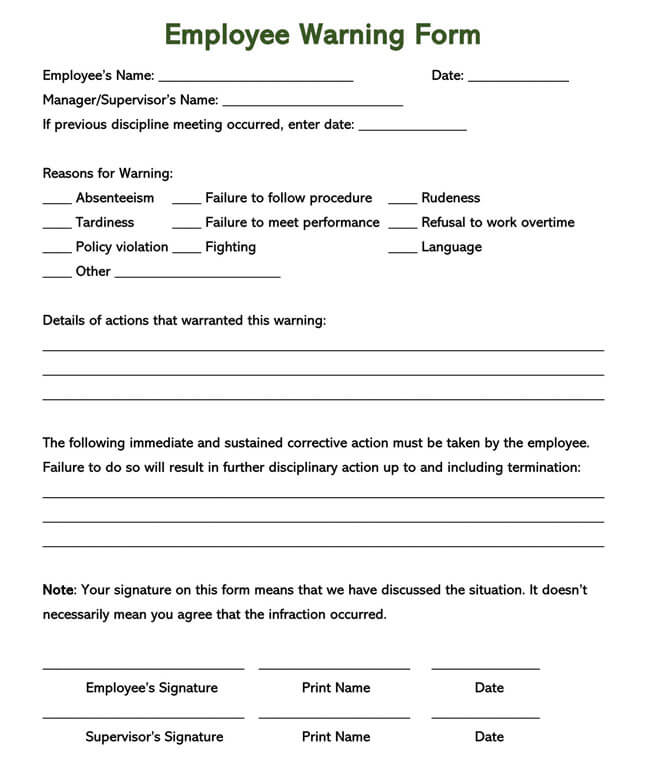
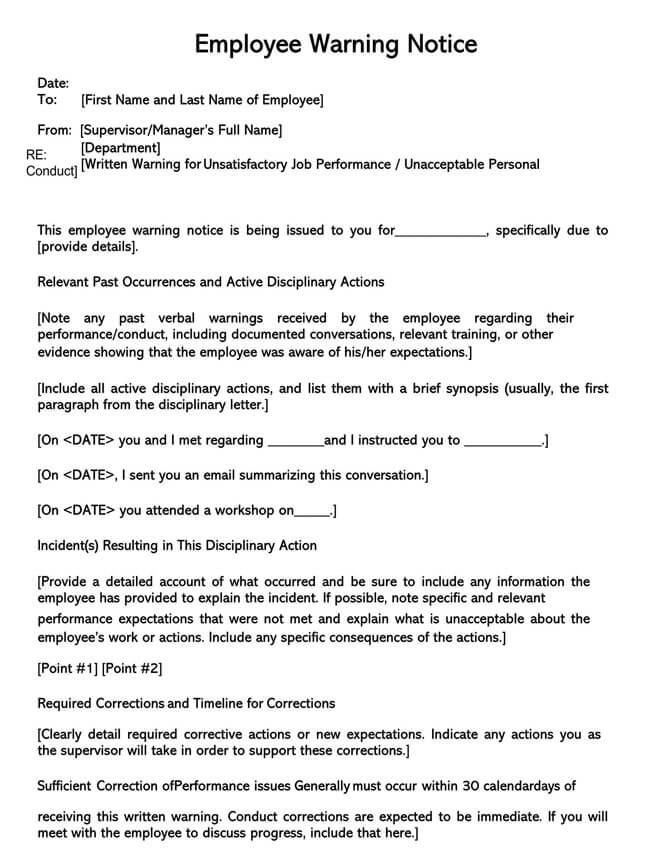
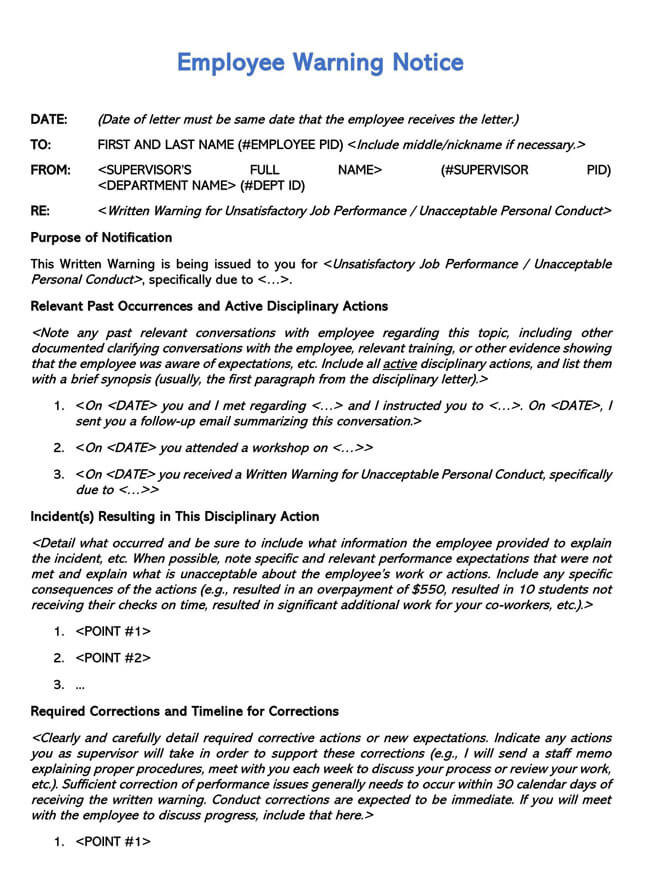
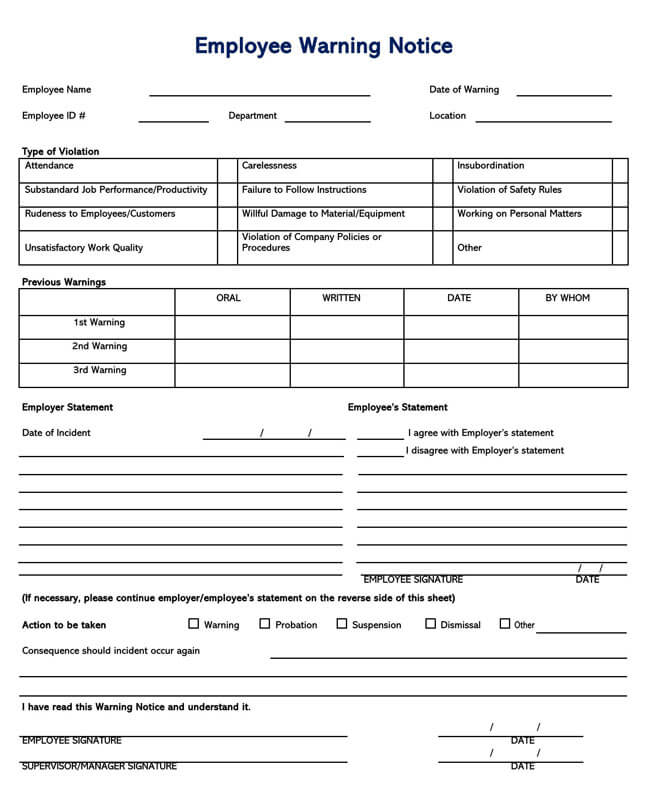
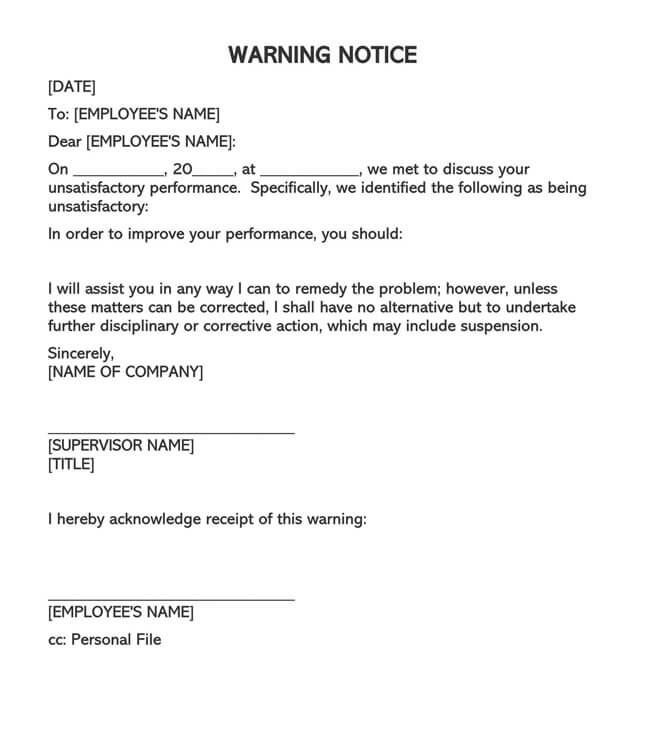
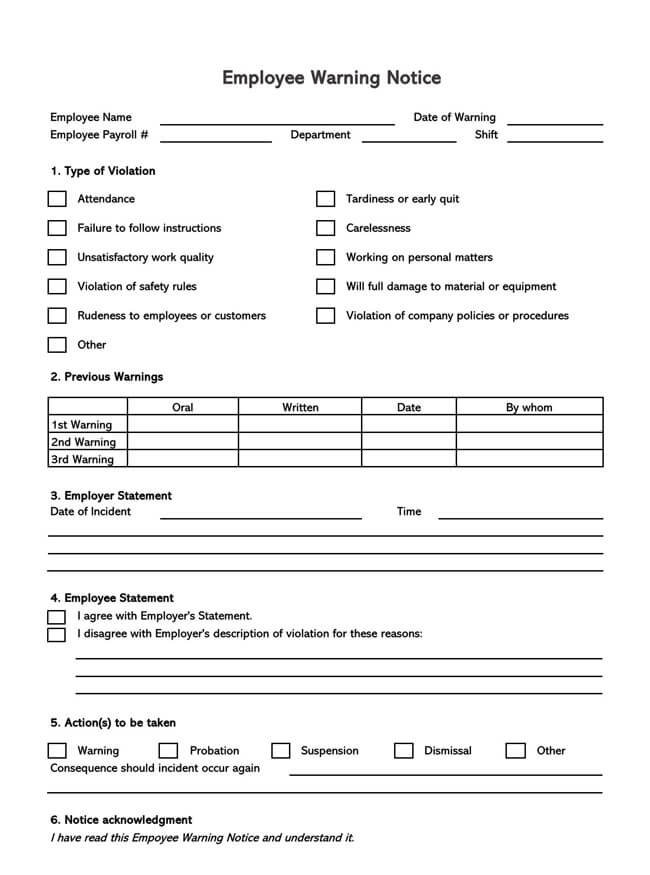
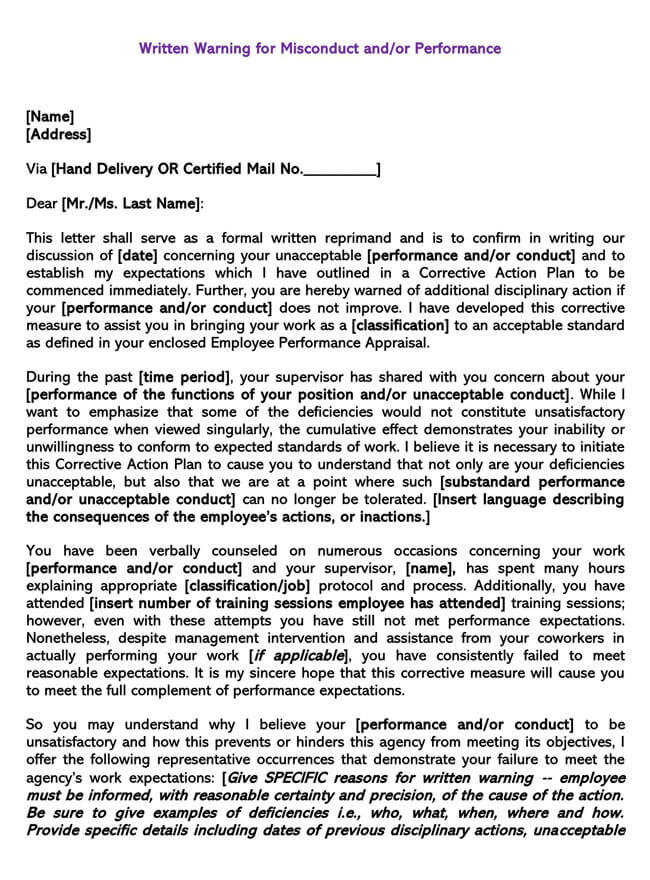
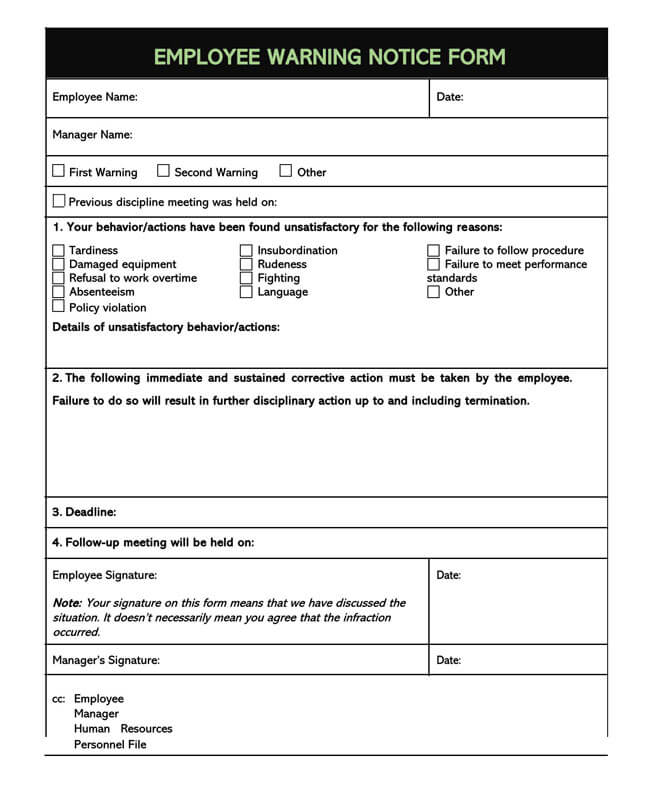
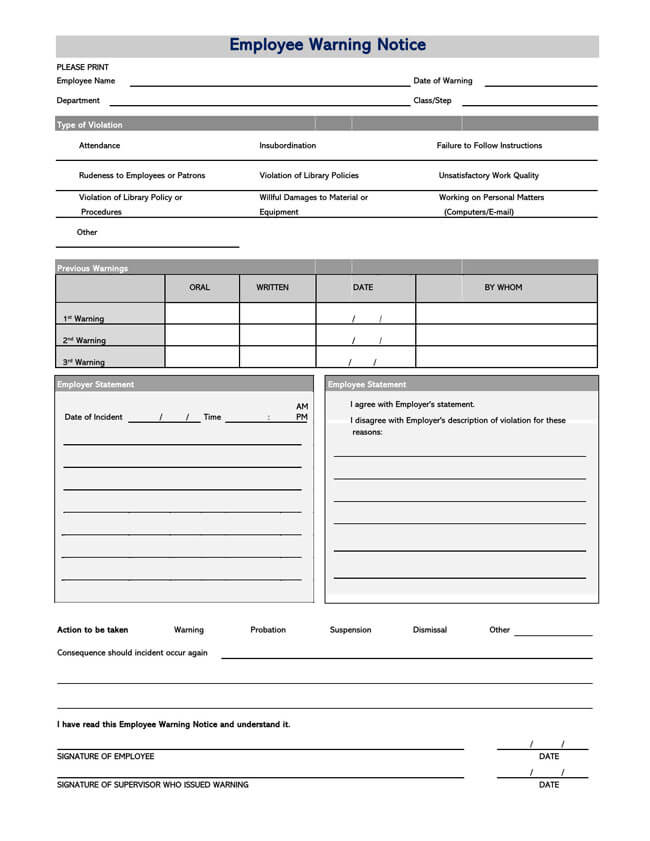
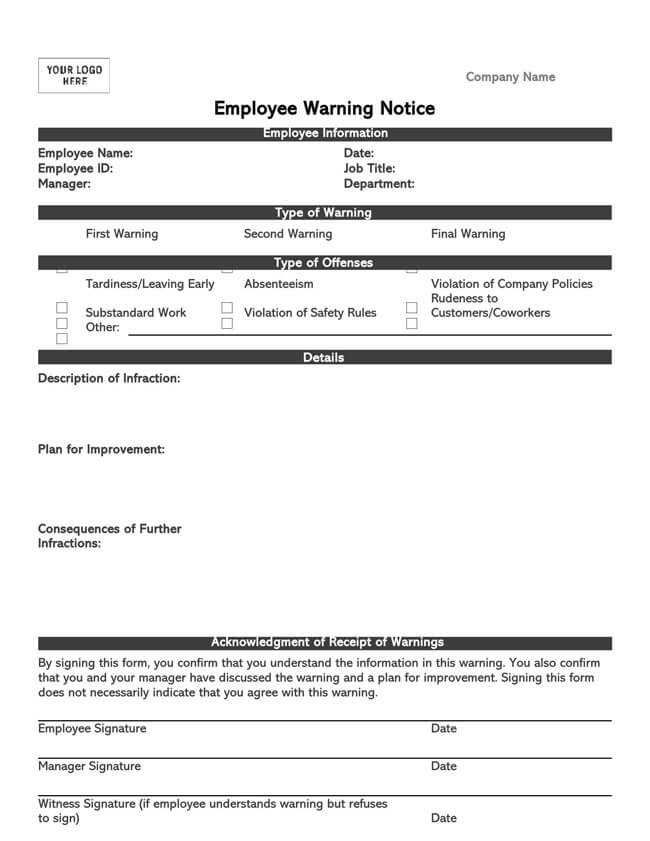
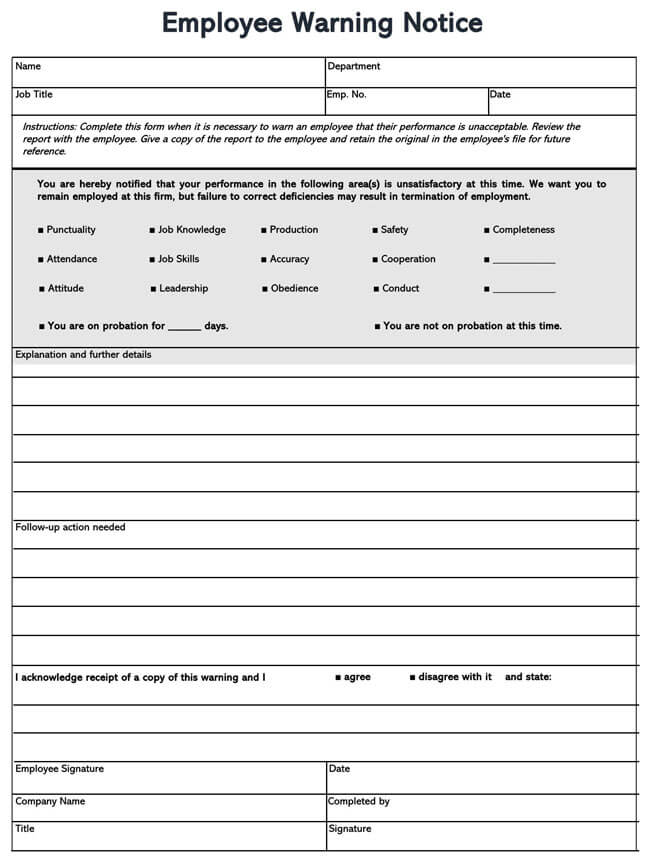
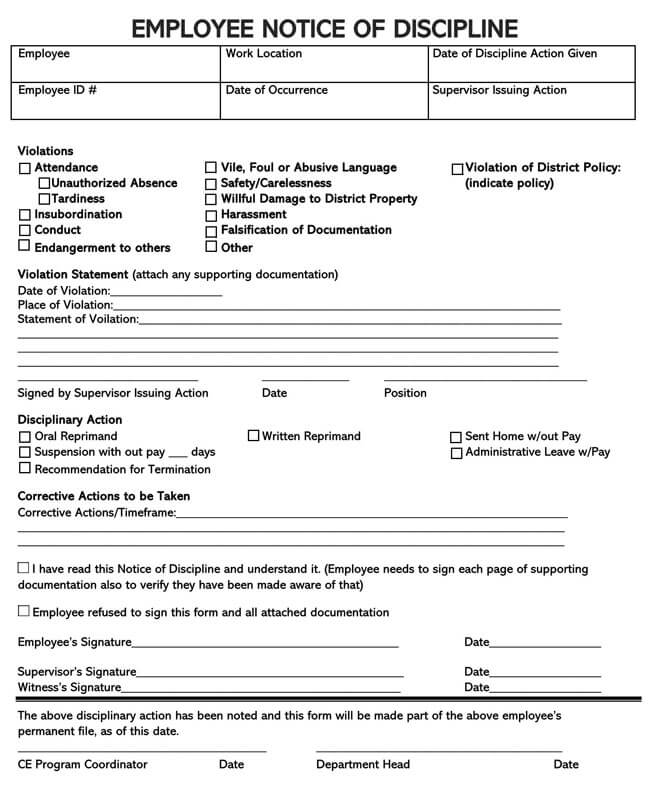
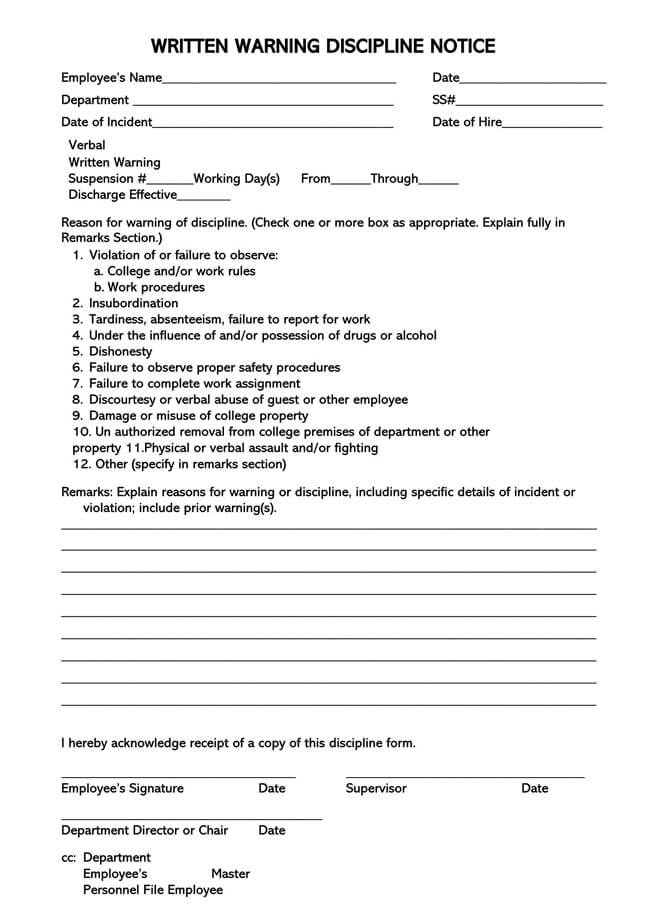

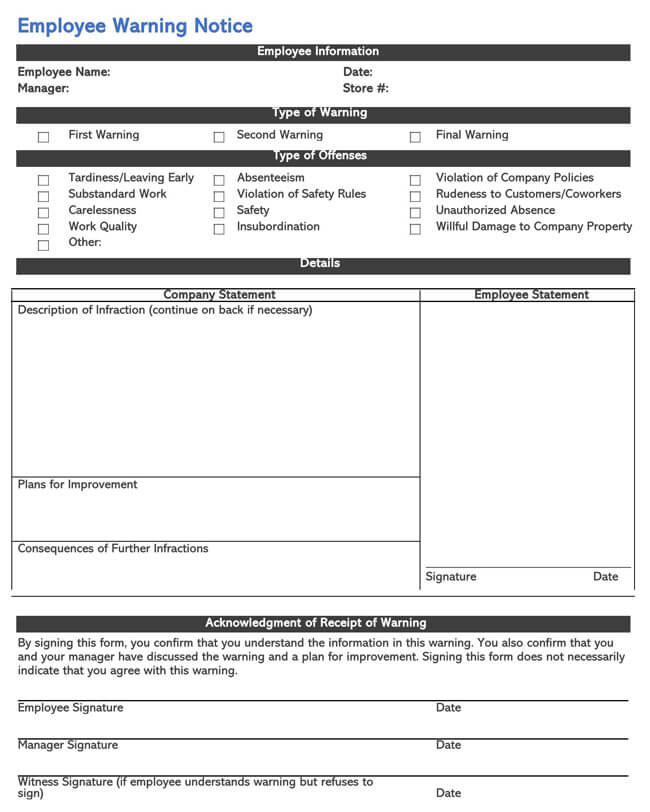
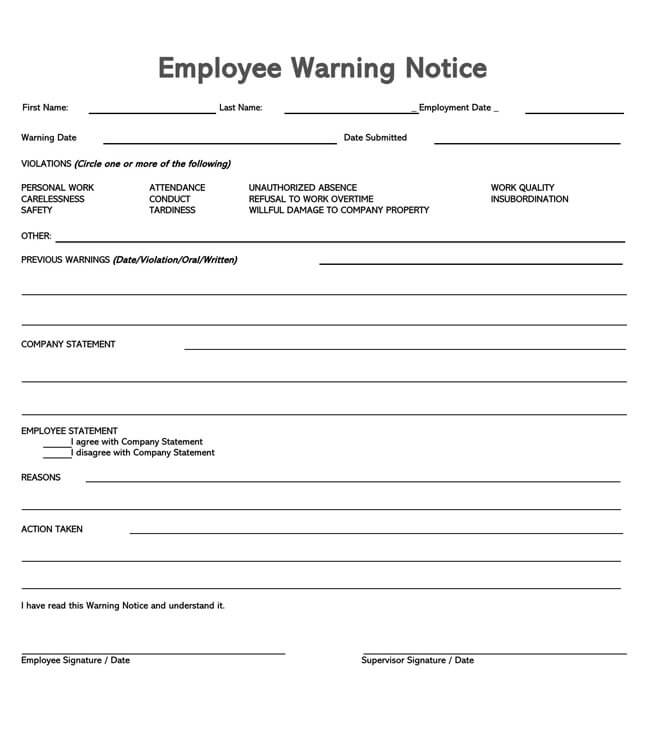
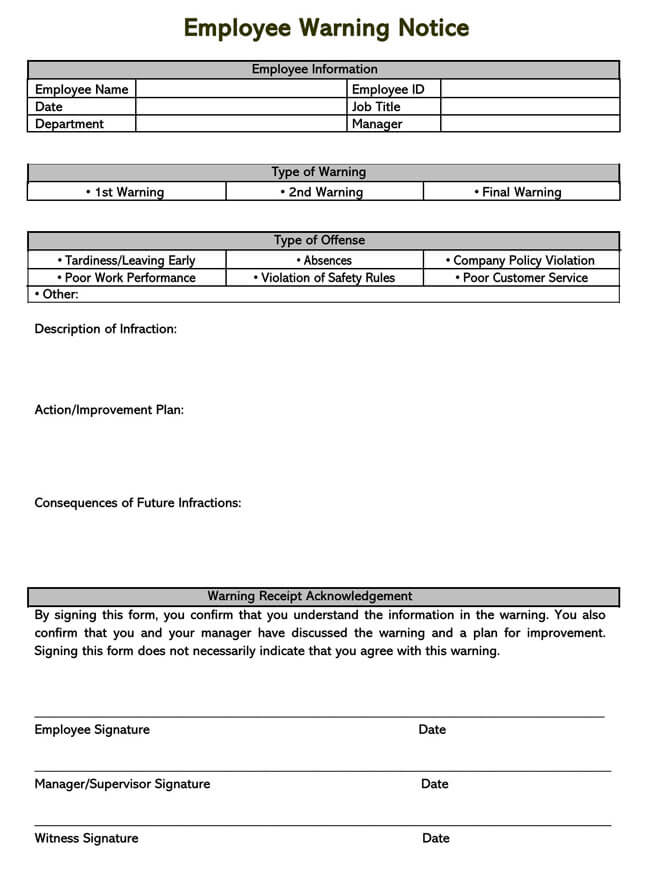
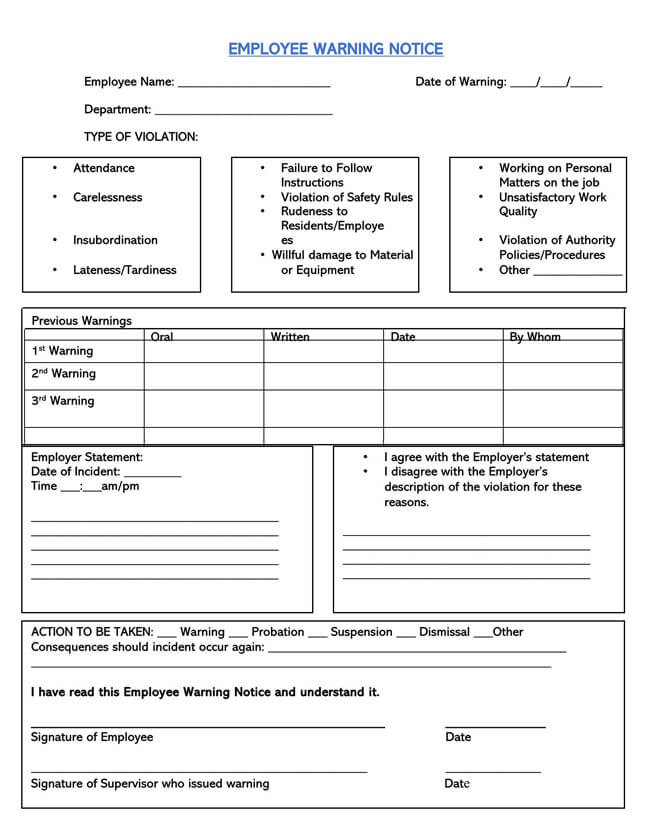


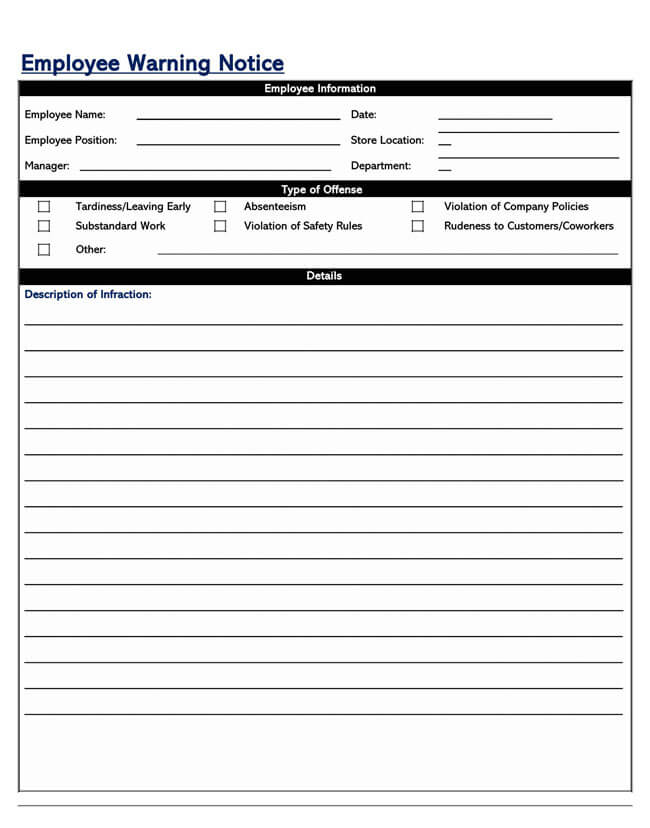
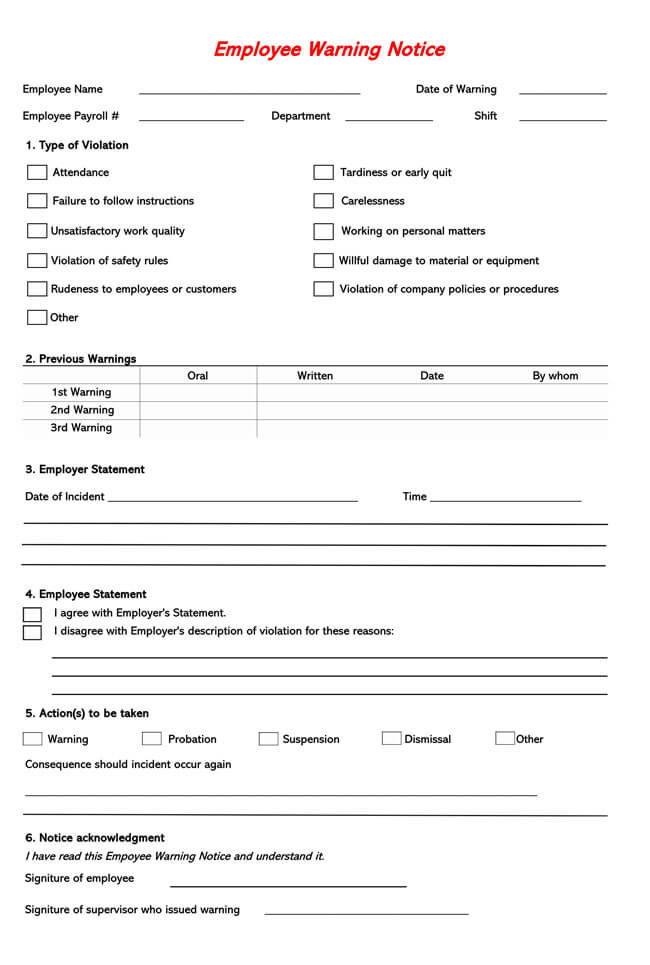
Components of the Warning Notice
When writing a warning notice, an employer should aim to ensure their position on the issue is well communicated and clearly knows what it means to be issued a warning notice.
A wholesome warning notice should contain the basic items discussed below:
Company information
The first item on the notice is the name of the company or organization. This should be as it appears on official documents of the company. It is meant to clearly identify the company associated with the employee and the warning.
Warning number
A warning notice should also state the number of warnings it represents. Depending on company policies, an employee can be given more than one warning, especially for minor offenses. For grave misconduct, in most institutions, one official warning is enough.
Name and date of issuing the notice
The employee’s name should identify him. This should be exactly as it appears in the official company records. This way, it is clear who is being addressed in the notice.
Job position (Job title)
The capacity in which he was operating within the company should be outlined. This could be a technician, administrative assistant, janitor, manager, etc.
Manager’s information
The name of the manager or supervisor charged with overseeing the conduct and performance should also be indicated. This should be as it appears on official company records.
Human resources in charge
The name of the HR representative involved with issuing the warning should also appear in the note, if applicable. After this is given, the issuing date can then be included.
Introduction
An introductory statement to the issue at hand should be given. Within the introduction, the employee’s misconduct can be listed. The notice should be direct to the point and specific.
Address policy violation
The employer should go ahead and point out the policy (ies) the employee is violating. This procedure can be done by quoting a particular section of the company policy or reference specific rules that have been broken.
Outline liberties
The warning notice should also outline other actions that might have been taken to remedy or correct the issue at hand. Liberties could be in the form of a personal intervention such as a verbal warning or meeting to try and resolve the matter. If this is the case, it should be stated, and the date declared accordingly.
Enlisting the consequences of failure
The notice should outline the expected consequences of persistent misconduct. This can be additional warnings if the issue is not too detrimental, job suspension, which could be without pay or even termination of employment.
Expected improvements
The employer can opt to give a “grace period” to effect change; if this is the case, it should be declared. Change can be evidenced through increased performance/ results.
Signatures
Both employer and employee need to include signatures where they seem necessary.
- Supervisor signature and date: The supervisor should be provided along with their signature and the date when they signed. This is proof of their knowledge of the notice and their support for the same.
- Employee signature and date: The employee should then provide their name and next to it their signature. This is to ascertain that he has read and has agreed to the contents of the notice.
Acknowledgment statement
To ensure that he is bound to the addressed concerns and measures outlined in the notice, an acknowledgment statement should be included.
Follow-up date to monitor progress
Lastly, a follow-up can be included in the notice. This can be after a given interval of maybe days or weeks.
It is essential to monitor one’s progress, so necessary steps can be taken if no changes are evident.
Sample Warning Notice
Warning 1
Employee Name: John Doe
Job Title: Warehouse Manager
Supervisor Name: Harry Finder
HR Representative: Nancy England
Date: 5th February 2021
Dear: John Doe,
Your Supervisor has reported to HR that you have violated the Jets Mac Publishers Ltd policies, Article 2: Attendance Threshold Guidelines. This has been evidenced through;
• Infraction one (1): Failed to meet the attendance percentage of 85% in three (3) months in the last year.
• Infraction two (2): As a result of poor attendance, there has been a direct cause of delays in delivery to five (5) clients who have made formal complaints, leading to loss of money in the amount of $1050 as compensation to our clients for the inconvenience.
It has been evidenced that you were issued a verbal warning through a meeting held at the Supervisor’s office on 20th November 2020 and 4th January 2021. Corrective actions agreed on are;
• To improve your attendance to the bare minimum of 85%
• Sign in with the head office daily until the 85% attendance is realized.
• Hand in weekly delivery reports.
We would like to communicate that if the aforementioned corrective measures are not realized, HR recommends the following consequences;
Third verbal warning
Second written warning notice
Job suspension without pay for 20 days.
Termination of employment
The company is determined to sustain the existing relationship with you, and your skills and knowledge as our [job title] are highly appreciated. We will continue to support you and others as best as we can, and hopefully, you can support the company by meeting our standards in quality delivery and performance.
Supervisor Name: Harry Finder
Signature: _______
Date: 6th February 2021
Employee Acknowledgement: I hereby acknowledge having violated company policy in the mentioned ways. To that effect, I am willing and capable of making the necessary corrections as required by Jets Mac Publishers Ltd.
Employee name: John Doe
Signature: _______
Date: 6th February 2021
Warning Notice Template
[Company Name]
Warning [Number]
[Employee Name]
[Job Title]
Supervisor [Name]
HR Representative [Name]
[Date]
Dear [name]
Your Supervisor has reported to HR that you have violated the [company name] policies, that is, [specific rules]. This has been evidenced through;
• Infraction one (1): Explanation
• Infraction [Number 2, 3, 4….): Explanation [if there is more than one infraction]
It has been evidenced that you were issued a verbal warning through a meeting held at the Supervisor’s office on [Date]. Corrective actions agreed on are;
• Corrective action one (1)
• Corrective action [Number 1, 2, 3, 4…]
We would like to communicate that if the aforementioned corrective measures are not realized, HR recommends the following consequences;
Consequence one (1)
Consequence two (2)
Job suspension without pay for a duration of [days/weeks]
Termination of employment (should be the last course of action should other disciplinary measures fail)
The company is determined to sustain the existing relationship with you, and your skills and knowledge as our [job title] are highly appreciated. We will continue to support you and others as best as we can, and hopefully, you can support the company by meeting our standards in quality delivery and performance.
Supervisor Name: _______ Signature: _______ Date: _______
Acknowledgement: I hereby acknowledge having violated company policy in the mentioned ways. To that effect, I am willing and capable of making the necessary corrections as required by [Company Name].
Employee Name: _______Signature: _______Date: _______
Tips To Consider
To ensure the employee is up to standard and as effective as intended, he must consider using useful and considerable tips.
There are few items one can implement to improve the mentioned characteristics of the notice:
- Try a verbal warning before issuing a written warning: It is advised that written warning notices be issued after intervention through a verbal warning fails, and his performance or misconduct persists. The warning should be through a personal (one-on-one) meeting. He should be allowed to communicate the cause of the issue before the employer can recommend corrective actions.
- Be clear when describing infractions: When describing infractions, the employer should be as specific as possible by providing details such as dates and people involved.
- End the notice with a positive statement: The employer should express their support throughout the corrective phase to show their appreciation for the employee’s input.
Frequently Asked Questions
Firstly, identify the problem and details like how long it has been going on. Then meet the employee and issue a verbal warning. Create the warning letter and ensure you include all the relevant details. Lastly, issue the warning notice and ensure they sign to ascertain that they have read and agreed to the issue.
There are a wide range of reasons, but the common ones include; absenteeism, consistent sub-standard work, poor performance, inappropriate behavior, insubordination, illegal conduct, and any other company policy violation.
A warning notice can be sent via email or a printed copy delivered by Hr. I emailed, ensuring that the title subject indicates what the notice is for. Alternatively, a manager can hold a meeting with him and hand them the notice.
Yes. This is usually a requirement as a matter of official record to confirm that the employee was informed about the issue at hand and agrees to it. However, he can refuse to sign if they disagree with the contents of the notice.
Primarily, it should outline the issue/violation, proposed corrective measures, and consequences of failure to change. Other details include employee name, manager/supervisor’s name, signatures of witnessing parties, and relevant dates.
Primarily, it should outline the issue/violation, proposed corrective measures, and consequences of failure to change. Other details include employee name, manager/supervisor’s name, signatures of witnessing parties, and relevant dates.
A warning will typically highlight failures on the employee’s part and ways to correct them, usually for minor misconducts. The termination will typically outline the cessation of employee duties. It can be a result of serious offenses such as fraudulent activity, workplace harassment, or violence.
After issuing the warning notice, a manager can hold a meeting with the employee to discuss how to move forward. They can raise their concerns and commit to seeing the corrective measures through. Monitoring and follow-ups should then be used to see that he is following the agreed-on actions. Where there are improvements, the manager should acknowledge.
As employees are allowed to refuse to sign if they disagree with the letter’s contents, a manager can indicate that the “employee refused to sign” and indicate why he declined to sign.




